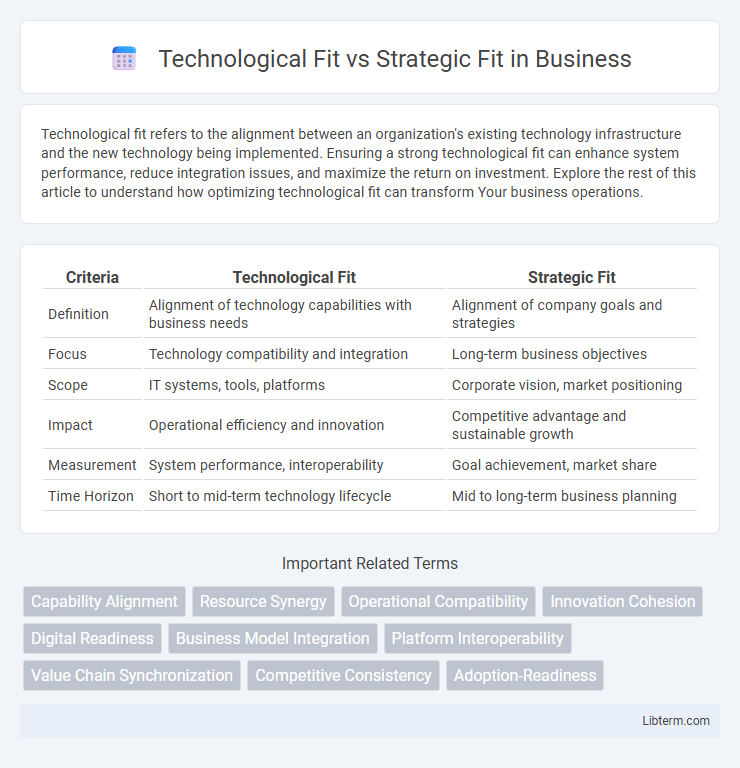Technological fit refers to the alignment between an organization's existing technology infrastructure and the new technology being implemented. Ensuring a strong technological fit can enhance system performance, reduce integration issues, and maximize the return on investment. Explore the rest of this article to understand how optimizing technological fit can transform Your business operations.
Table of Comparison
| Criteria | Technological Fit | Strategic Fit |
|---|---|---|
| Definition | Alignment of technology capabilities with business needs | Alignment of company goals and strategies |
| Focus | Technology compatibility and integration | Long-term business objectives |
| Scope | IT systems, tools, platforms | Corporate vision, market positioning |
| Impact | Operational efficiency and innovation | Competitive advantage and sustainable growth |
| Measurement | System performance, interoperability | Goal achievement, market share |
| Time Horizon | Short to mid-term technology lifecycle | Mid to long-term business planning |
Understanding Technological Fit
Technological fit refers to the alignment between an organization's existing technological capabilities and the specific requirements of a new technology or innovation. It ensures that the technologies can be integrated smoothly without excessive cost or disruption, optimizing operational efficiency and scalability. Assessing technological fit involves evaluating compatibility, infrastructure readiness, and the skill level of the workforce to effectively leverage new technology.
Defining Strategic Fit
Strategic fit refers to the alignment between an organization's internal resources and capabilities and its external environment, ensuring that business activities support overarching long-term objectives. It emphasizes the coherence among various strategic components, such as market positioning, competitive advantage, and core competencies, to maximize organizational effectiveness. Achieving strategic fit enables firms to sustain competitive advantage by integrating strategies with environmental demands and stakeholder expectations.
Key Differences Between Technological and Strategic Fit
Technological fit refers to the compatibility between a company's existing technology resources and the technology required to execute a project or strategy, emphasizing operational efficiency and innovation capability. Strategic fit centers on the alignment between a company's overall business strategy and its external environment, ensuring long-term competitive advantage and market positioning. Key differences include technological fit's focus on internal capabilities and specific technological assets, whereas strategic fit prioritizes broader business goals, market dynamics, and organizational direction.
Importance of Technological Fit in Modern Organizations
Technological fit is crucial for modern organizations as it ensures that digital tools and systems align seamlessly with existing processes, boosting operational efficiency and innovation capacity. This alignment reduces integration costs and accelerates time-to-market for new products and services. Organizations with strong technological fit are better positioned to adapt rapidly to evolving market demands and maintain competitive advantage.
The Role of Strategic Fit in Business Success
Strategic fit plays a crucial role in business success by aligning organizational resources and capabilities with external market opportunities and threats, ensuring sustainable competitive advantage. Companies that achieve strategic fit effectively integrate their long-term goals with operational processes, market demands, and stakeholder expectations, leading to enhanced performance and growth. Unlike technological fit, which centers on the compatibility of tools and systems, strategic fit emphasizes cohesive alignment across all business dimensions to drive superior outcomes.
Assessing Compatibility: Criteria for Technological Fit
Assessing technological fit requires evaluating compatibility in terms of existing infrastructure, software integration, and scalability potential to support future innovation. Key criteria include alignment with current technology standards, interoperability with legacy systems, and the ability to enhance operational efficiency. Ensuring technological fit minimizes implementation risks and maximizes return on investment in digital transformation projects.
Aligning Technology with Corporate Strategy
Aligning technology with corporate strategy ensures that technological investments support long-term business goals and competitive advantage. Technological fit evaluates how well specific technologies integrate with existing systems and processes, while strategic fit assesses the coherence between technology initiatives and overall business objectives. Achieving both fits maximizes innovation effectiveness and drives sustainable organizational growth.
Challenges in Achieving Both Fits Simultaneously
Achieving both technological fit and strategic fit simultaneously presents significant challenges due to conflicting priorities between innovation and long-term business goals. Technological fit demands rapid adaptation to evolving technologies, while strategic fit requires alignment with organizational vision and market positioning, often leading to resource allocation conflicts. Balancing these demands necessitates agile management practices and continuous reassessment of both technological capabilities and strategic objectives.
Case Studies: Technological vs Strategic Fit in Practice
Case studies reveal that technological fit emphasizes aligning a company's IT infrastructure and capabilities with operational needs, while strategic fit focuses on harmonizing technology initiatives with long-term business goals. For example, Samsung's success in integrating advanced semiconductor technology demonstrated a strong technological fit, enhancing production efficiency, whereas Apple's consistent alignment of product innovation with brand strategy exemplifies strategic fit. Companies leveraging both fits achieve sustainable competitive advantages by ensuring that technology investments support core business strategies and operational excellence.
Best Practices for Balancing Technological and Strategic Fit
Achieving an optimal balance between technological fit and strategic fit involves aligning technology capabilities with organizational goals and market demands to ensure seamless integration and competitive advantage. Best practices include conducting thorough technology assessments aligned with strategic objectives, fostering cross-functional collaboration between IT and business units, and continuously monitoring technological trends to adapt strategies proactively. Implementing agile frameworks and iterative development processes further supports dynamic alignment, maximizing both technological efficiency and strategic impact.
Technological Fit Infographic

 libterm.com
libterm.com